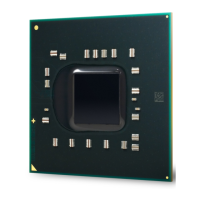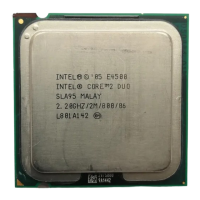Thermal Management Logic and Thermal Monitor Feature
Thermal and Mechanical Design Guidelines 31
4 Thermal Management Logic and
Thermal Monitor Feature
4.1 Processor Power Dissipation
An increase in processor operating frequency not only increases system performance,
but also increases the processor power dissipation. The relationship between
frequency and power is generalized in the following equation: P = CV
2
F (where
P = power, C = capacitance, V = voltage, F = frequency). From this equation, it is
evident that power increases linearly with frequency and with the square of voltage.
In the absence of power saving technologies, ever increasing frequencies will result in
processors with power dissipations in the hundreds of watts. Fortunately, there are
numerous ways to reduce the power consumption of a processor, and Intel is
aggressively pursuing low power design techniques. For example, decreasing the
operating voltage, reducing unnecessary transistor activity, and using more power
efficient circuits can significantly reduce processor power consumption.
An on-die thermal management feature called Thermal Monitor is available on the
processor. It provides a thermal management approach to support the continued
increases in processor frequency and performance. By using a highly accurate on-die
temperature sensing circuit and a fast acting Thermal Control Circuit (TCC), the
processor can rapidly initiate thermal management control. The Thermal Monitor can
reduce cooling solution cost, by allowing thermal designs to target TDP.
The processor also supports an additional power reduction capability known as
Thermal Monitor 2 described in Section
4.2.3.
4.2 Thermal Monitor Implementation
The Thermal Monitor consists of the following components:
• A highly accurate on-die temperature sensing circuit
• A bi-directional signal (PROCHOT#) that indicates if the processor has exceeded
its maximum temperature or can be asserted externally to activate the Thermal
Control Circuit (TCC) (see Section 4.2.1 for more details on user activation of TCC
via PROCHOT# signal)
•
FORCEPR# signal that will activate the TCC.
• A Thermal Control Circuit that will attempt to reduce processor temperature by
rapidly reducing power consumption when the on-die temperature sensor indicates
that it has exceeded the maximum operating point.
•
Registers to determine the processor thermal status.

